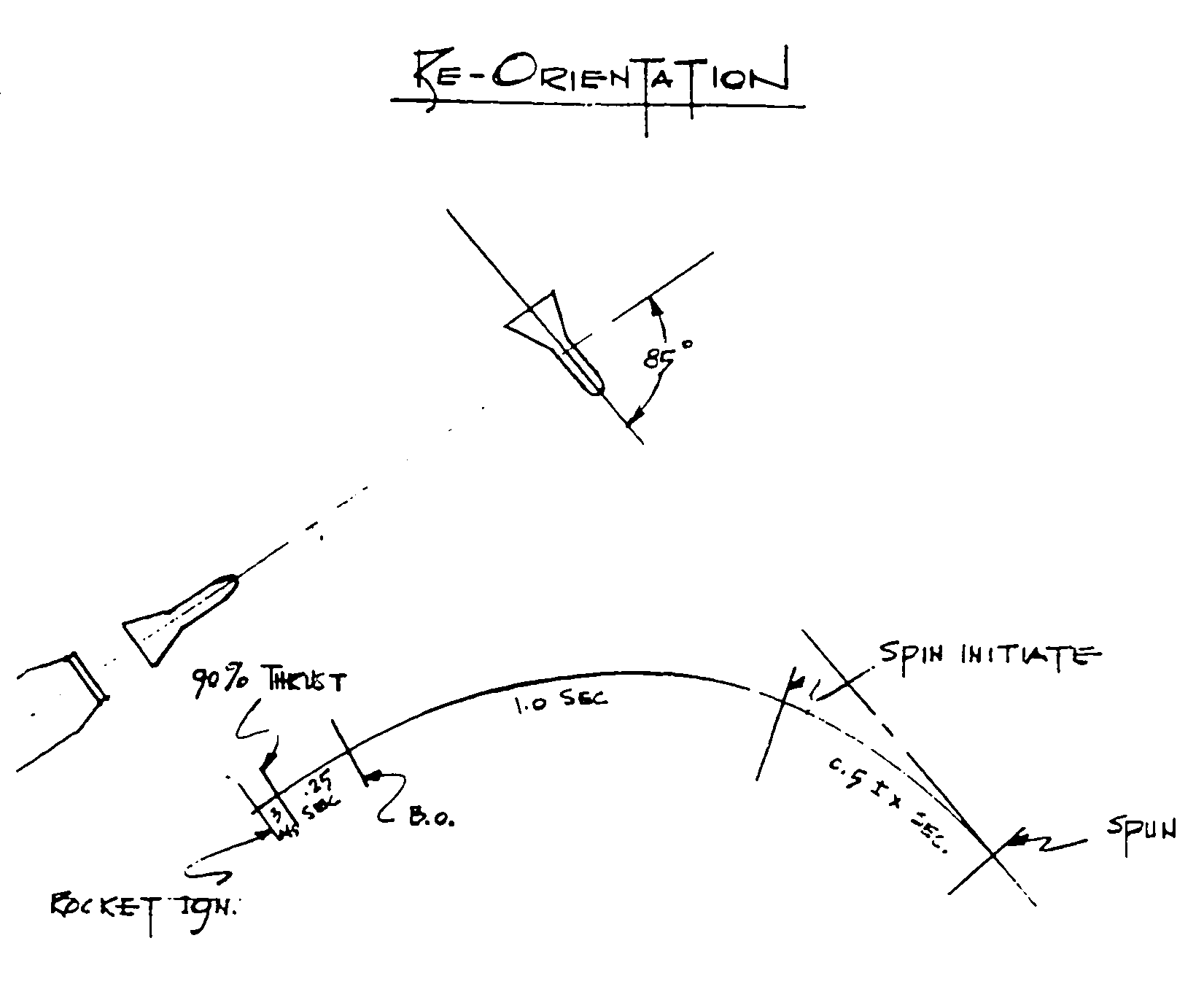
Figure 5
- - - - - - - - - - - - - - - - - - - - - - - - - - - - - - - - - - - - - - - - - - - - - - - - - - - - - - - - - -
|
POLARIS A3 WEIGHT AND PERFORMANCE SUMMARY ML 404-138 CONFIGURATION |
||||
|
ITEM |
A3P |
A3E |
A3X-21 |
A3X-1 |
|
1ST STAGE |
23,563 |
23,538 |
23,595 |
23,595 |
|
Propulsion |
23,155 |
23,155 |
23,155 |
23,135 |
|
Propellant |
20,730 |
20,730 |
20,730 |
20,480 |
|
Inert |
2,425 |
2,425 |
2,425 |
2,655 |
|
Ballistic Shell |
117 |
117 |
117 |
117 |
|
Flight Control |
146 |
146 |
146 |
166 |
|
Electrical |
110 |
120 |
125 |
125 |
|
Contingency |
35 |
-- |
-- |
-- |
|
Instrumentation |
-- |
-- |
52 |
52 |
|
2ND STAGE |
10,330 |
10,441 |
10,532 |
10,633 |
|
Propulsion |
9,498 |
9,498 |
9,498 |
9,500 |
|
Propellant |
8,880 |
8,880 |
8,880 |
8,835 |
|
Inert |
618 |
618 |
618 |
665 |
|
Ballistic Shell |
256 |
275 |
275 |
249 |
|
Equipment Section |
120 |
139 |
139 |
134 |
|
Nose Fairing |
136 |
136 |
136 |
115 |
|
Flight Control |
327 |
327 |
327 |
443 |
|
Electrical |
95 |
106 |
120 |
123 |
|
Guidance |
75 |
75 |
82 |
88 |
|
Contingency |
79 |
-- |
-- |
-- |
|
Instrumentation |
- - |
160 |
230 |
230 |
|
MISSILE GROSS WEIGHT |
34,943 |
35,029 |
35,177 |
35,278 |
|
RANGE (90% Repeatable) |
2,500 |
2,360 |
2,225 |
1,950 |
Figure 10
- - - - - - - - - - - - - - - - - - - - - - - - - - - - - - - - - - - - - - - - - - - - - - - - - - - - - - - - - -
RE-ENTRY BODY REPORT
DISCUSSION
[DELETED PARAGRAPH OR TWO]
"Now coming to the events of the report itself, we report five recent decisions. We have had first to decide on a fuller definition of penetration aids, flight test objectives, and hardware. Our second decision is not to eject the Mark 2 re-entry body rocket motor after burn-out. Third, we have initiated a feasibility study about incorporation of special warhead arming controls in both the Mark 1 and Mark 2 re-entry systems. Fourth, we have been directed to participate, as the Admiral defined It yesterday, in the development of an Air Force Medium Range Ballistic Missile. Fifth, the Mark 1 arming and fuzing device evaluation program has been completed and is satisfactory in all respects. The AFD is considered to have met the military characteristics provided for it.
"Gentlemen, you have heard of our penetration aids program, and figure 1, while somewhat cluttered,shows the re-entry body as seen from aft of the four and one half inch cylindrical extension to the missile needed to carry some of the appurtenances in the system. The decoys, their mounting brackets, and the two ECM packages are visible, as is a modified Mark 2 ejection motor. We took the motor right off the development line, straightened the nozzles, and misaligned the thrust slightly to get pitch-over and separation. You can also see one of the three chaff ejectors.
"Figure 2 looks into the re-entry body with that four and one half inch extension off. Again you can see the eject rocket motor, the two ECM packages, the chaff ejector, and the single spin nozzle used in lieu of the tube that we have in the Mark 1 system now.
"Figure 3 looks back from the re-entry body to the missile equipment section, and shows the configuration and geometry of the six decoys that we propose to carry.
"Figure 4 is a view looking straight down on the re-entry body and shows essentially the same detail as with the one chaff ejector that is going with the REB here.
"Lockheed has generated a mix-master operation in Building 103 under the direction of one of the people in the Re-entry Systems Division. Hardware procurement and ground testing are proceeding very rapidly and a great part of the ground test program is under way now. Contracts and project work orders have been let for all the hardware components. Rocket motors themselves are being developed under duplicate phase I contracts with Goodrich and Amcel. The chaff package development is let with Los Alamos and Nortronics. The ECM package is let with Raytheon and LEC. The other hardware is being developed by Lockheed. We look to a flight date of 20 July for the first of these systems.
"One of the things that we were addressing primarily in this system was to decrease radar cross section both of the re-entry body itself, and in the way of providing increased separation between the second-stage motor and the re-entry body. This we are accomplishing, as shown in figure 5, with a single Mark 2 eject rocket with the straight nozzles. By misaligning the thrust slightly we get the needed increase in separation. This ejection would occur in the normal fashion, with the air spring. As soon as the decoys have been ejected, the eject motor itself will fire and carry the REB out to an increased separation velocity of 45 or 50 feet per second.

Figure
5
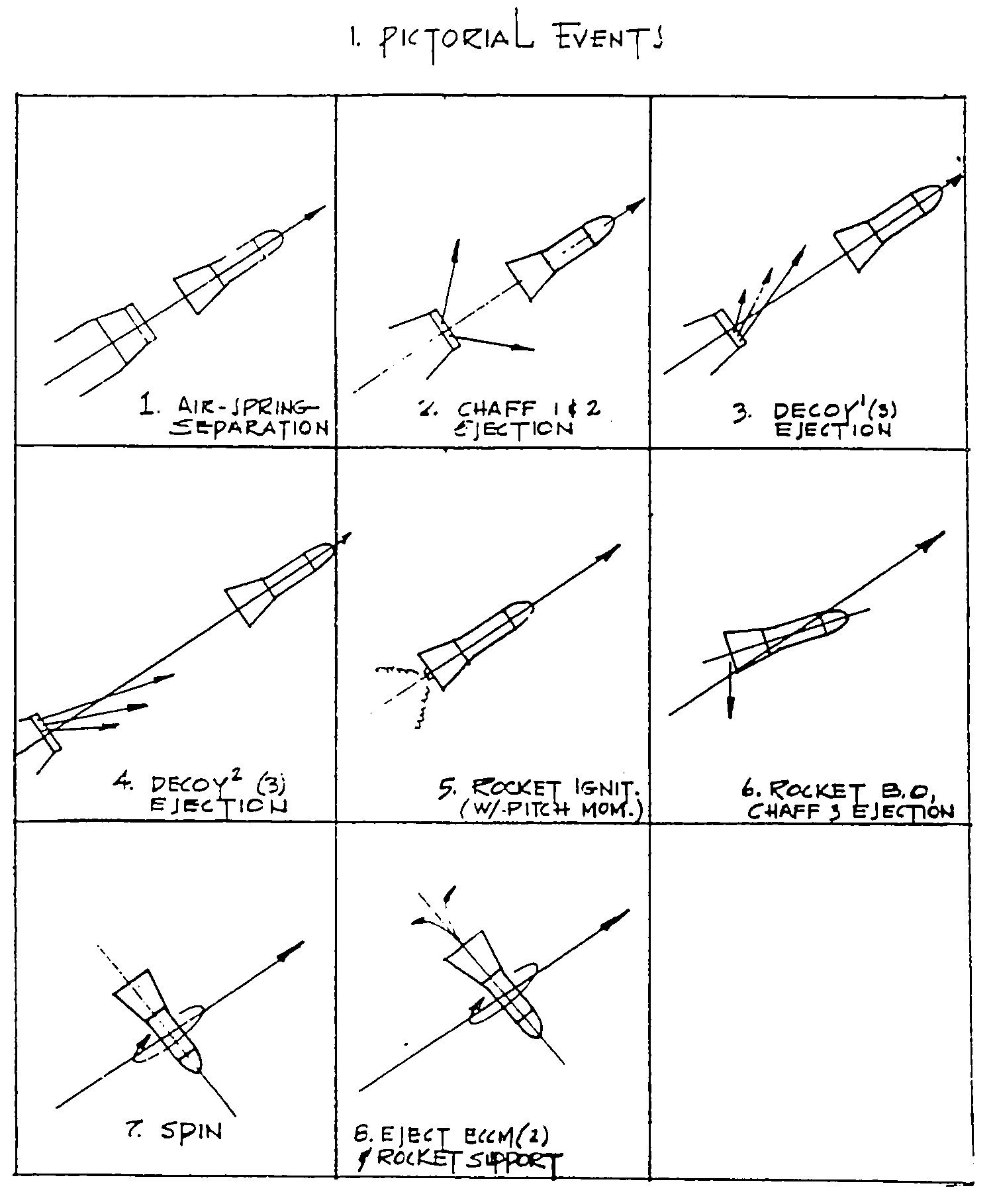
Figure
6
"At the same time, because of thrust misalignment, there will be a pitch motion imparted to the re-entry body, with the pitch rate around a radian per second maximum. Through the modification to the spin system, this pitch will be arrested about 85° after it starts; because we have only the single nozzle to arrest it and kill the angle of momentum, we will have a rotation of approximately 20°. On re-entry then, our angle of attack will not be zero, as we might have hoped, but around 20°.
"This technique accomplishes the two things cited earlier: one, to erect the re-entry trajectory for low radar cross-section, and two, to increase the separation between the second stage and the re-entry body to 35,000 or 40,000 feet at our maximum range. As you can see in the figures, we are keeping on the exit fairing, as it will further reduce the radar cross section until it burns off at roughly 250,000 or 300,000 feet."
Admiral Smith interposed a question about the tolerances on the thrust misalignment of the eject rocket. After calculating briefly, Commander Julian supplied the following; An error has been assumed in the cant angle separation of the rocket with the expected center of the re-entry body of ±5 minutes of arc; this translates to a ±2.6° per second pitch or yaw; and this seems to be the maximum contribution in terms of the residual rotation angle.
Mr. Peterson asked if the alignment would be done at NWA. Commander Julian replied that much of it would be handled in the design of the support structure, which Lockheed was completing.
Commander Julian then reviewed a pictorial sequence of events for the Mark 1 re-entry body, given in figure 6, and he was questioned at length by Dr. Draper concerning the exact procedures and the timing of the events. In reply, Commander Julian explained the events as follows:
1. The air-spring separation moves the re-entry body out along the axis of the missile.
2. Chaff is ejected at an angle to the flight axis.
3. Three decoys are ejected in an upward direction.
4. Three additional decoys are ejected in downward directions. During steps 2, 3, and 4, re-entry body separation distance gradually increases from additional increment provided in first step.
5. Rocket ignition occurs. Because the thrust axis is somewhat misaligned with the geometric axis, this supplies pitch motion to the re-entry body. The firing of this rocket is controlled by a sequential programmer in the flare of the reentry body. Up to this point, the missile has zero momentum about its axis, being stabilized by its own inertia. The rocket burns out in 0.25 second.
6. The re-entry body assumes the pitch motion and ejects a third package of chaff. This lasts only about 1.5 seconds before the ignition of the single nozzle spin system occurs. At the moment of the spin system ignition, the pitch motion should be 58° per second.
7. Ignition of the spin system Changes the axial position of the re-entry body and applies rotation on top of the pitch motion that previously existed. At this point, its motion provides it wich about a 20° cone angle. In the exosphere, the REB presents this aspect for radar cross-section, which is a substantial improvement over conditions in a broadside presentation. We realize another advantage in orienting by keeping the exit fairing.
8. Finally the ECCM and the rocket support are ejected.
"Figure 7 shows a little more detail about the REB separation, " continued Commander Julian, "and how those rockets shown in the first four slides are ejected. Ejection occurs very quickly during that part of the separation phase when the re-entry body is being separated by the air-spring impulse, not the rocket impulse
"Figure 8 depicts a threat tube of the kind we hope to get. We have four decoys patterned ahead of and two behind the re-entry body. The second stage that we have separated out would be flying low by a distance of 35,000 feet or thereabouts.
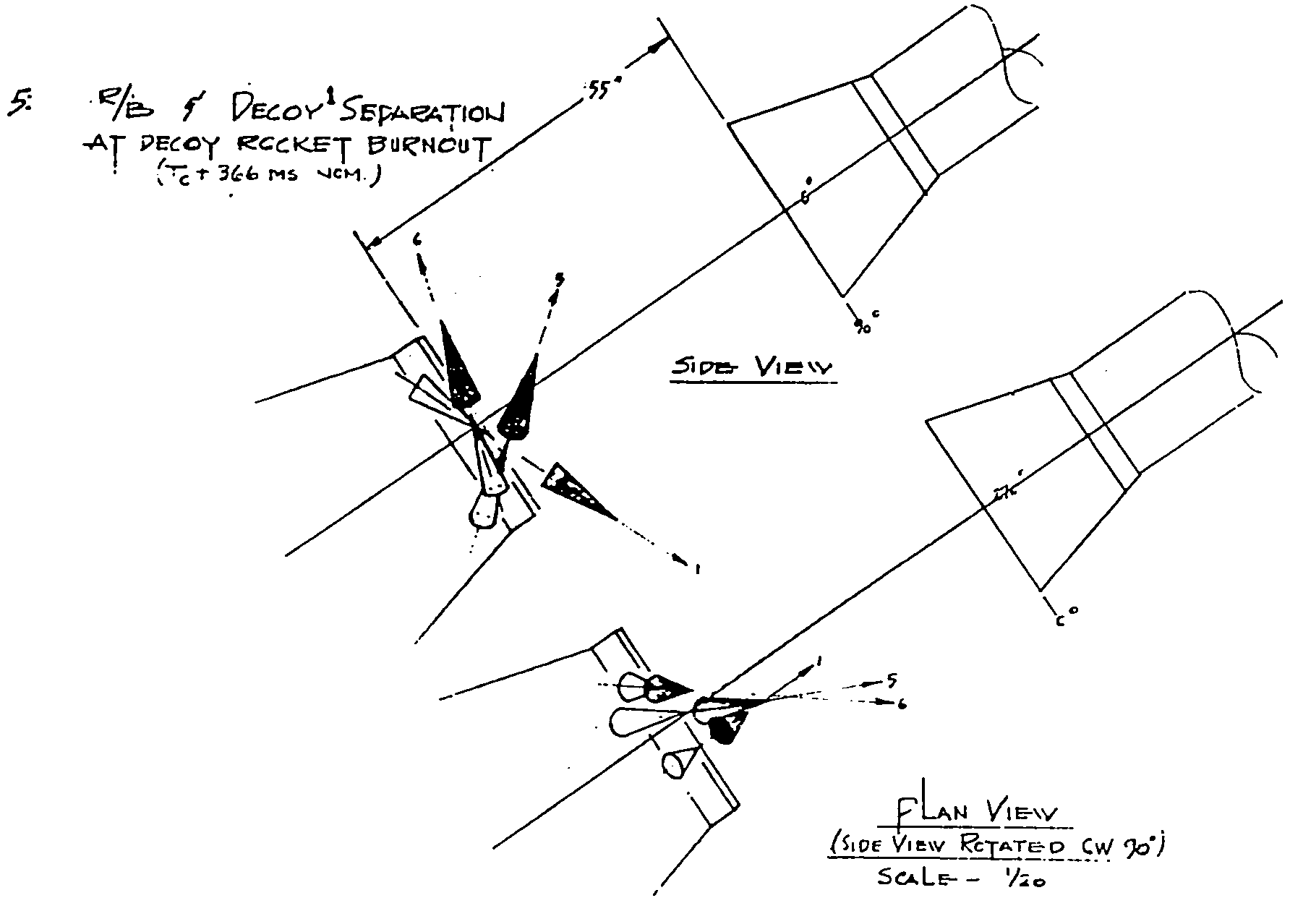
Figure
7
"This pattern can be varied, but we selected this as giving optimum separations between each of the decoys. Any element in the re-entry tube is more than what we consider to be the lethal radius of the X-rays. This will, we hope, perturb defense, as also may the chaff package."
Dr. Mechlin suggested that an enemy would only have to shoot at every fifth object coming in, and Commander Julian, admitting the possibility, said that a test program was going to take place that would determine whether existing radar could make any clear distinction between the objects.
In response to questions from Admiral Smith, Commander Julian explained that the decoys would each have a very small rocket motor weighing about one-half pound, and that the decoys would have a somewhat different radar cross section. Mr. Peterson asked about the results if the test program proved that no distinction could be made between decoys and REB's. Commander Julian explained that the object would be to have the enemy shooting at all objects because he, in turn, could not discriminate between the real and the decoy.
[DELETED PARAGRAPH OR TWO]
"We hope the ECM package will also deny range information. If the enemy has the ability to adjust his radar frequency well off the frequencies for which the chaff is going to be cut (and we do not think he does), maybe this ECM package will do us some good. At least it will carry us lower in altitude before he can get range information."
In response to a question from Mr. Peterson, Commander Julian explained that the penetration-aid system was calculated as 95 per cent reliable, and that its decrement to the over-all missile reliability would be only 0.0084. Captain Clarke asked about the randomizing ability so that the warhead would not always be running fifth in the group, and Admiral Smith suggested that one simple way of changing the pattern of the incoming objects would be through omission of some of them. Commander Julian agreed.
Showing a second view of the threat tube, figure 9, which defined the placement of objects more clearly and indicated how they might appear on a Radar "E" Scan, Commander Julian introduced the question of reliability and mentioned that warhead reliability was unaffected by the penetration aids, although the over-all missile reliability might be. The warhead would fail safe, as far as its tactical employment is concerned, and would detonate, as this would be a function of the fuze antennas. Commander Julian added that a new ground point is needed for the Surface Penetration Fuze, but preliminary tests here indicate that this need will not affect performance.
Commander Julian also explained that the defense system was the same as has been assumed by the Air Force, and certainly is a reasonable one to expect for the period from 1963 on, even though there has been no common agreement as yet among the services about a good defense model.
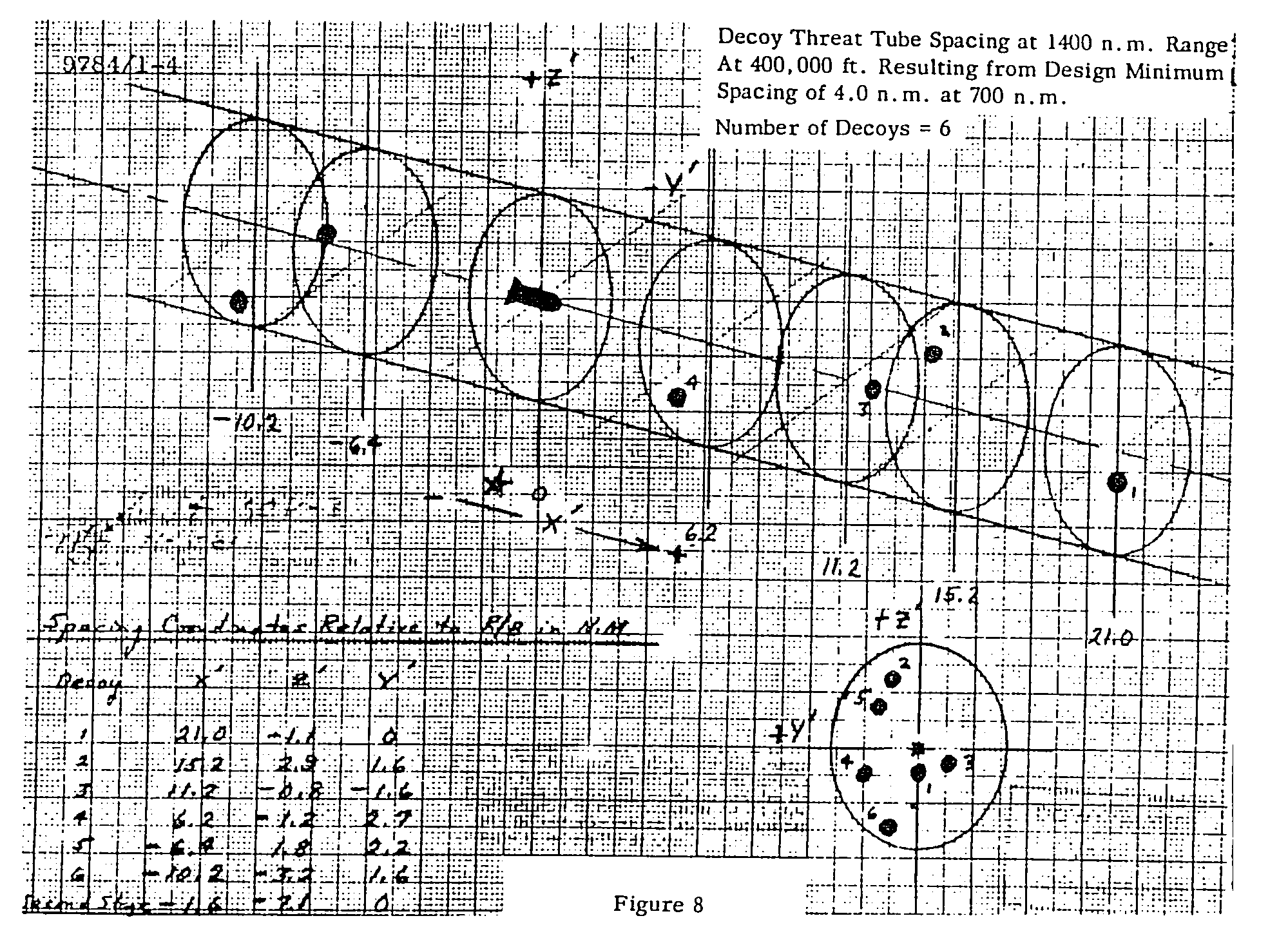
Figure
8

Figure
9
"They are presently devising, " continued Commander Julian, "a great number of defense models to test the different missile system; This one, known as the SA-4, is somewhat similar to the NIKE-ZEUS system except that the missile performance is lower. When we did our own systems penetration studies, we used SA-4 for the radar capabilities, frequencies, et cetera, and used the ZEUS system for the response, and calculated the interdiction.
"I mentioned that the second stage would be separated from the re-entry body at about 35,000 feet maximum range. It becomes less at the lower ranges, but it does not get closer than about 25,000 feet.
"Figure 10 covers the vulnerability of our Mark 1 re-entry body to neutrons at about that altitude, showing a damage threshhold and a kill threshhold. This is specific to one kind of warhead, the one with boron in the stress cushion. Not all of these Mark 1 warheads are so configured.
"Concerning the shapes in figure 11, we decided to retain the exit fairing; again, in deciding on the design of the decoys specifically, we went through a small study on the effect on frontal cross section. We hope to use shape B, keeping its exit fairing, pointing the nose somehow, or putting some radar attentuating materials on the existing blunt nose.
"Figure 12 illustrates the cross section of the B version in terms of the S-band frequency, which is about the frequency estimated by intelligence for the tracking radar of the SA-4 system (3000 megacycles). Our decoy is the solid line, while the dotted line is the signature of a shape B re-entry body as a function of aspect angle from the n
[POSSIBLY DELETED PARAGRAPH OR TWO]
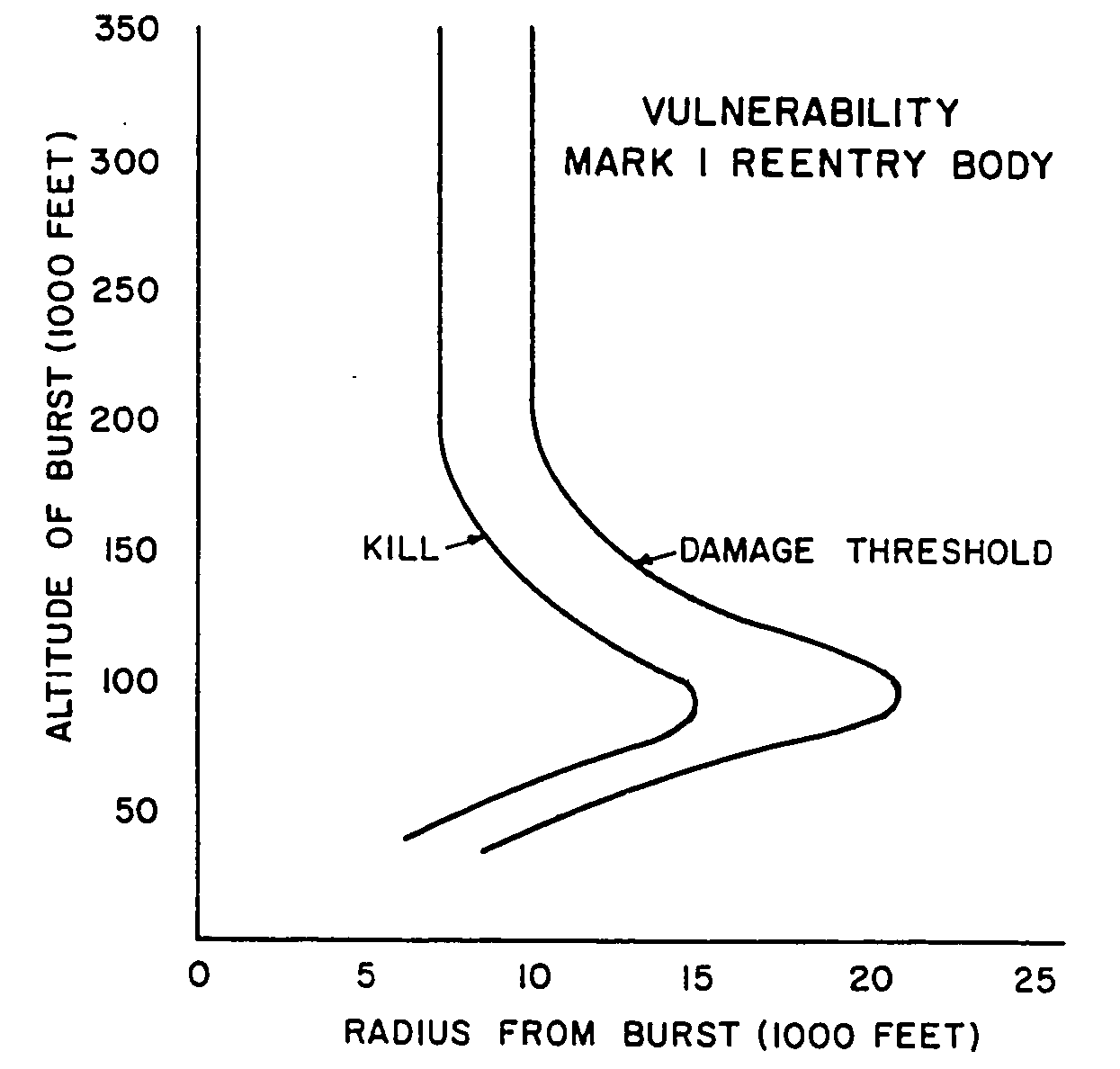
Figure
10
"This may look to be a miserable fit, but actually it is not bad. This little body will be tumbling, since it is not spun up for stabilization in any way, at a tumble rate of 17 or so per second. Thus it will scintillate much like the cross section scintillates with aspect angle. Random motions of the re-entry body will cause it also to scintillate so this may be a rather good comparison.
"Figure 14 goes to the point of cross section, and shows the difference between those four configurations. Shape A is admittedly side-on and comes in at 85°. Shape C was the pointed nose. Shape RAM had radar attenuating material on the blunt nose. We selected Shape B easily by taking the eject mechanism out of the exit fairing. We plan to coat the inside of the fairing with some sort of metallic coat to provide a radar return from it and not the shape behind it.
"The fairing will burn off long after the maximum heat pulse on the re-entry shield itself, and at a time when we are at such an altitude that the defense system really has not much chance to get to it about 200,000 feet.
"Figure 15 shows some curves on how the defense could discriminate against decoys, the chaff, second stage, and the REB. If, for instance, he is able at these velocities, 14,000 to 15,000 feet per second, to discriminate delta V of 100 feet per second, then he can detect the REB coming out of the chaff someplace around 250,000 feet. He can see a velocity discrimination between second stage and the REB somewhat lower, and he can detect the decoy at about 200,000 feet. The design criteria for the decoy specified that it should have about the same ballistic characteristics down to 200,000 or 250,000 feet and should have approximately the same radar cross section. None of our decoys or other PX system hardware configurations is designed to do anything but look at radar; they do not counter IR, optical discrimination or any kind of depth radar. We hope that the decoys will penetrate much lower before altitude discrimination becomes possible because of the possibility that small arms capability might be able to fragment the re-entry body. We do not have results from any fragmentation studies on the system, but we do know that if the REB is hit with a pellet of sufficient size and velocity, it can be damaged considerably. If the decoys can penetrate to 25,000 or 50,000 feet, the defense, whether he is using a radar or just shooting at targets, will have to take the decoys under attack. This diversity of targets will assist us if he has that capability.
In response to questions, Commander Julian explained that the flight test program would begin about 20 July. Mr. Parran asked about size of the decoys, and was informed that they were 10.5 inches in length, 1.5 inches in diameter, and having a nose, cylinder and flare.
"Why do they appear as big as the re-entry body?" asked Mr. Parran.
"They do this in terms of radar, " explained Commander Julian, "as we have reduced the radar cross section of the re-entry body until it appears to be more the size of the decoys. The scintillation will add somewhat to the similarities. In the decoys we wish to get a good radar return, and thus we wish a well defined break between the nose and cylinder. I admit that the comparison pictures do not seem to indicate that the two items are similar, but until actual entry conditions I feel sure they will be closely similar."
Asked about reflectance, Commander Julian explained that while they had initially designed a tungsten nose, they found that catastrophic oxidation occurred below 200,000 feet; presently they are working with a less blunt nose with steel or graphite so that it will penetrate down to possibly 25,000 feet. Commander Julian also cited the changes in aspect angle as providing sharp differences in radar return between the decoy and the re-entry body.
"Is your 200,000-foot figure based on some sound estimate of defense capability, " asked Captain Clarke, "or is it simply the best you can do?"
"The estimate was determined by combing the best features of the SA-4 and the NIKE-ZEUS systems, " replied Commander Julian, "and from all we presently know, the SA-4 will be the defense system used in the future, it will proliferate after 1963, and it means that radar will instrument the defense system at the point of defense. "
At this time Admiral Smith called for the luncheon recess.
After the meeting reconvened, discussion began on the firings at Kwajalein Island. The following details were affirmed by Commander Julian and Admiral Smith: The object of the test is to fire a missile at the Kwajalein atoll, tracking it with defensive radar; range personnel will require a track and destruct capability which they feel they can have with land-based gear based on Johnson Island or some smaller island even closer; Special Projects will not be footing the bill for the test program; NIKE-ZEUS gear will be used for. tracking; the acquisition and tracking radar will be on Kwajalein while the Tradex gear will be on Roi Island, the northern island of the Kwajalein atoll; and discrimination radar, which will not be available until much later, should give as good position as do the ZEUS tracking radars.
"How many people do they have on that island?" asked Admiral Smith.
"There will be about six thousand people on one end of the island which we will have to overfly according to present plans, " replied Commander Julian.
Admiral Smith observed that this overfly could lead to some sticky problems, and Commander Julian then returned to the presentation of his report.
"Figure 17 shows the present design of one of our small decoys. We intend to carry six decoys, each weighing about six pounds, and each with its own one-half pound ejection rocket. We expect about ±5 per cent impulse variation which will give us some variation on the threat tube. The decoys are heavy metal, possibly tungsten coated with steel or steel and graphite in the nose section. The cylinder is graphite; the flare is Teflon and we expect it to burn off at around 200,000 feet and then permit the decoy to continue on down to 25,000 or 50,000 feet. The ejection mechanism is by rocket with the latch shown.
Two contracts have been let recently for propulsion development on the eject motor, one at Goodrich and one at Amcel. Amcel, to date, already fired some motors. Goodrich has not yet but by 15 February we expect the results from the phase I study to be complete and will let the phase II contract for the flight test motors. The propellant weighs about three-tenths of a pound. We are looking for specific impulse of about 9, 13, and 18 pound - seconds.
"The initial planning for our flight test included 12 vehicles with 12 A2 motors. In view of the potential loading of SSB(N)608 with A2's, Admiral Smith has informed us that we must plan for only four A2 motors, and these will fly from the pad into the Antigua Mils area. There are several reasons for this: One is that they are improving the TPQ-18 installation at Antigua to provide for a pre-detect recording and a capability of looking at a multiple array of targets in data form for analysis later, and two, Antigua will have an FPS-16. We also hope to get Trinidad radar on the air. Trinidad has seen these earlier development flights and has been able to analyze some of their tapes, and, though not requested to, has been able by looking at the scintillation between second stage and re-entry body, to pinpoint where the separation velocity is. I think they can cover us there.
"In addition, if we can get it, we want the DAMP ship assigned in the impact area. Now, just this morning, as a matter of fact, we heard that the DAMP ship is to be assigned to Joint Task Force Eight in June for an indefinite period. Further. ARPA is claiming that the DAMP ship has primary research objectives in the DAMP assignment and should not be assigned to development programs. Apparently a flail is coming up on possible assignment of the DAMP ship in the program.
"The DAMP ship is part of the Downrange Anti-ballistic Missile Measurements Program, an RCA-Operated vehicle. Not too long ago, the subject of DAMP usage was put to us in terms of needing the ship after the end of '62. ARPA was about to give the project up and for a while no one wanted it. Suddenly there are a multiple set of requirement put on it. This Task Force Eight assignment is a test operation, AEC requirement. It has objectives in the RANGER and AGENA programs plus ours, if we can get it. The ICBM impact areas are now one of the primary assignments and everybody has a use for the ship.
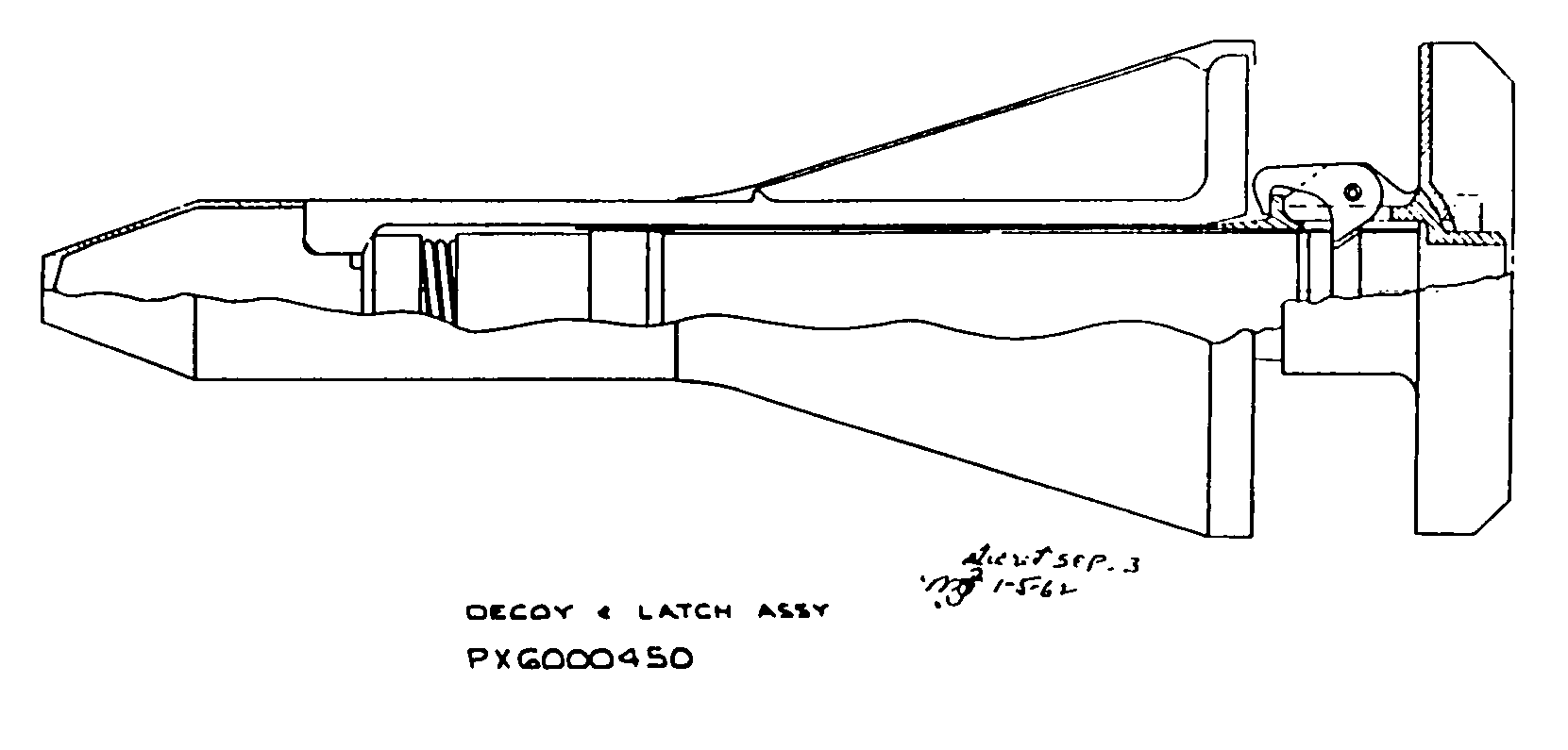
Figure
17
"The next four of our twelve flight test vehicles are to be used in the PX-1 program, which you recall is directed towards providing penetration aids for the Mark 1 system on A2 missiles only. The second four of those are programmed to go into Ascension, which has a TTR. Admittedly, it has not provided a great deal of data to date, but we have been assured by the operators that in September and October they are confident that they can give us multiple target tracking and pre-recording detection.
"The last four would be a systems demonstration into the Kwajalein-ZEUS complex. Admiral Smith has remarked on range safety criteria, and we know this to be a potentially difficult problem. If the SSB(N)608 does not get outloaded with A2's and if a chance occurs of our getting four A2's that late, we would like to fire in the Kwajalein area. The reason we feel we must go to the Antigua Mils area is that there are ballistic changes or dispersions because of the extra velocities and pitches given the re-entry system on ejection. These must be noted, corrected for if possible, and taken into consideration in targeting.
"If we do not go into a well-instrumented range, a range in which we know impact locations well from a known geodetic launch point, we cannot accomplish this. We cannot say that firing an A1 into the Mils would give us the same kind or quality of information. First, the dynamics of the A1 separation might be completely different leading to different ballistic dispersions. Second, the EAG is not now available. The EAG is committed starting 1 July, for about 55 days for the A3X checkout exercise. That ship is not available and we are committed to fire a minimum of these four A2's from the pad at Antigua. Going downstream on the last four A2's, I think that flying into Kwajalein at longer range will give us greater ionization effects and a better estimate of how the radars see the various pieces and bodies of the threat tube. It is now unlikely that we can get these four A2's because of the demands of the SSB(N)608 out-loading and the downstream outloadings, but if it were possible we would like to have them.
"The first flight is scheduled for 20 July, the second one, for later in July, two come in August into the Mils, two in September, and two in October into Ascension. We would like to fly four in November into Kwajalein, but I think it will be two in November and two in December. The ship must return in time to assume a commitment in the A3X in February . The A3X checkout has to be conducted in the period between the last SDAP support and the ARPA effort in September.
"Now, there were several questions about the effectiveness and the intercept capability of the defense that we had assumed. We considered the SA-4 system with radar like ZEUS and a missile of somewhat less performance, as our defense model. We compared this to the ZEUS for missile performance, in figure 18, to see how it would perform against this system.
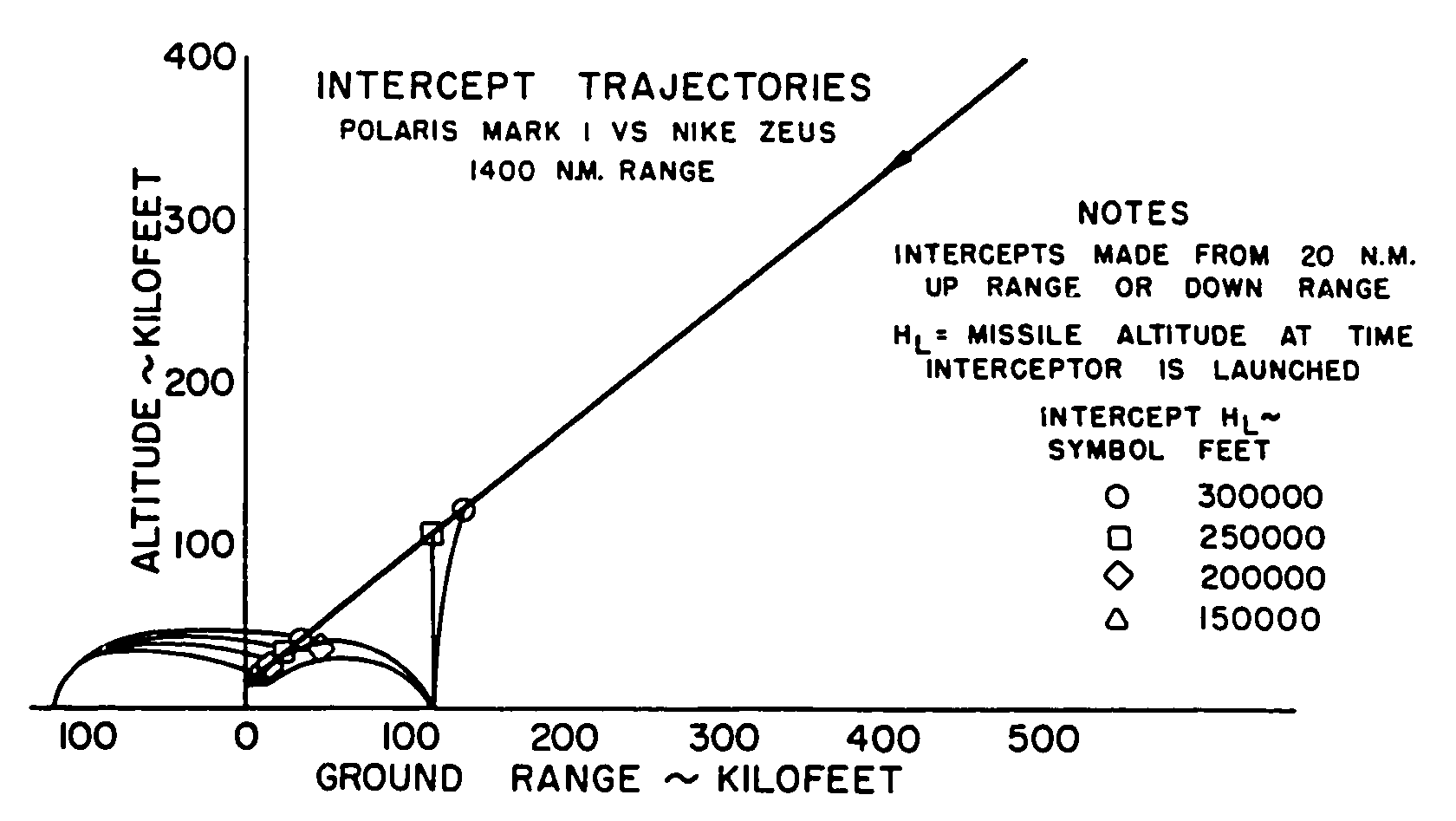
Figure
18
"In the assumed defense model the impact or target area has two ZEUS installations each located diametrically opposite, a 20 mile circle, and the intercepts are made in this case from 20 miles down range towards the impact direction. The circles show where intercept would occur if you launched when the incoming re-entry body is at 300,000 feet and you have solved the equations, you launch, and you intercept him at 125,000 feet.
"In our system we hope that chaff, the ECM, and the decoys, will not let the defense discriminate and get range information on the re-entry body until it is around 200,000 or 250,000 feet. If he discriminates and solves the equations at 250,000 feet, he will intercept at somewhere around 100,000 feet. If he cannot discriminate and solve until 200,000 feet, his intercept altitude is quite low, 40,000 feet. This figure shows how rapidly the intercept capability degrades as the altitude at which discrimination between the re-entry body and the other parts of the garbage decreases. The lower we can force this discrimination altitude, the more difficult it is for him to intercept at a reasonable altitude with a ZEUS-type system.
"Figure 18 was for a 1400-nautical mile range, but figure 19 shows three missile ranges, and predicts missile altitude at intercept or launch. Again, this goes to the point of where could he intercept using our assumed defense system if he could not discriminate until 200,000 or 50,000 feet or whatever. It is a function of range -- 1400 nautical miles, 200,000 feet. The actual intercept altitude under the assumptions is around 35,000 feet.
[DELETED PARAGRAPH OR TWO]
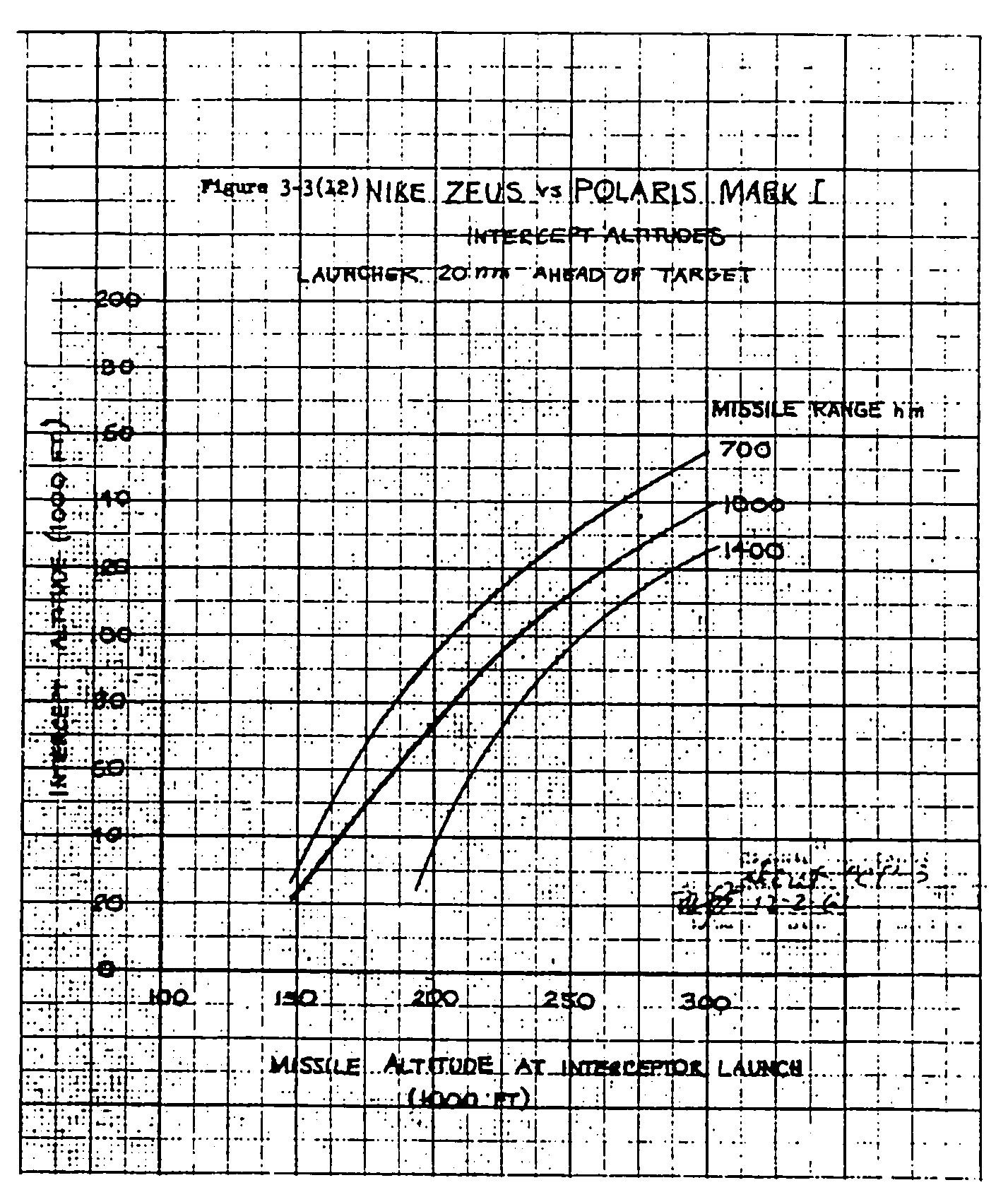
Figure
19
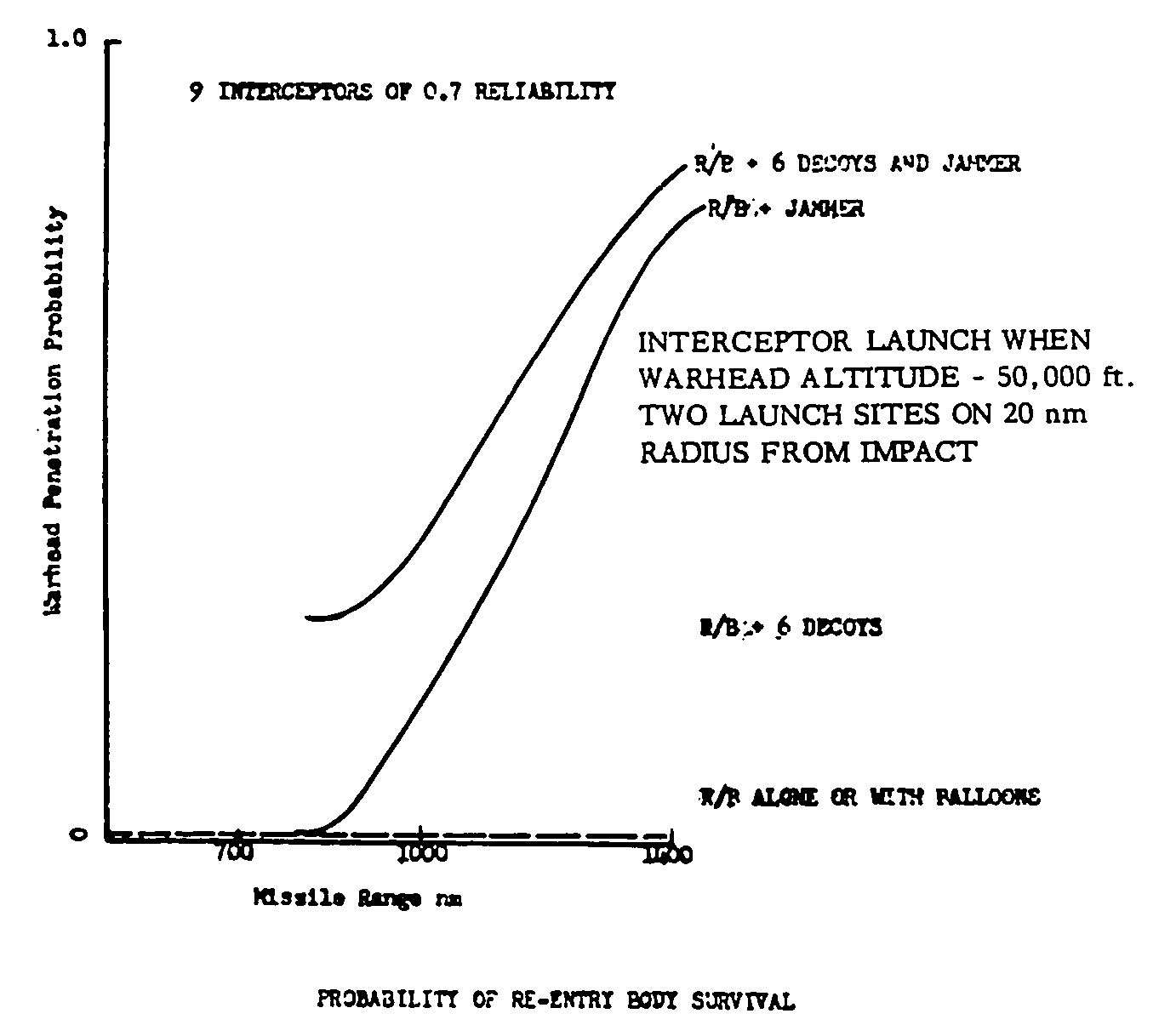
Figure
20
"The re-entry body plus six decoys alone cannot be seen, but lies at about 0.3. If we use an effective jammer that denies L-band acquisition range information and S-band tracking information down to 250,000 feet, the probabilities of warhead penetration improve and become substantially greater particularly at longer ranges.
[DELETED PARAGRAPH OR TWO]

Figure
21
"Figure 22 shows the flight test schedule, which I have already discussed in some detail. First flight date, 20 July, requires that we get the missile sometime in mid-April to check out at LMAF and AMR.
"Figure 23 follows in sequence, giving a PX-1 flight test participation chart and showing what we would like to fly on each of the 12 vehicles. On the four Antigua flights we would not carry chaff in all dispensers except on the fourth flight; on the early flights we would carry some reflectors to help the radar that we have on the air to get positioned in the appropriate place. We would not propose to carry active jammers until we flew into Kwajalein. We would have telemetering, L-band beacons, and reflectors before that time.
"Our latest integrated re-entry system design for Mark 2 is shown in figure 24. In this design we are cooperatively sharing the external package with the AEC to provide the re-entry flight structure as well as the warhead case. From our cooperative effort, we have gained some weight in the mid-cylinder area because the AEC had put in stiffening here, a honeycomb that added to the base stability and allowed us to decrease the magnesium substructure by one half the thickness.
"Again, as a result of integrating -- since we had planned space for the entire chaff package -- the AEC has been able to straighten the tube through which the safing wire is drawn to unsafe the warhead. This change reduced the torque requirement and increased the reliability of extracting the wire. According to the Livermore man on our design team, this saved about a million dollars in development on a higher torque vane motor and represents another significant advantage gained in this cooperation between the AEC and the other design groups.
[DELETED PARAGRAPH OR TWO]
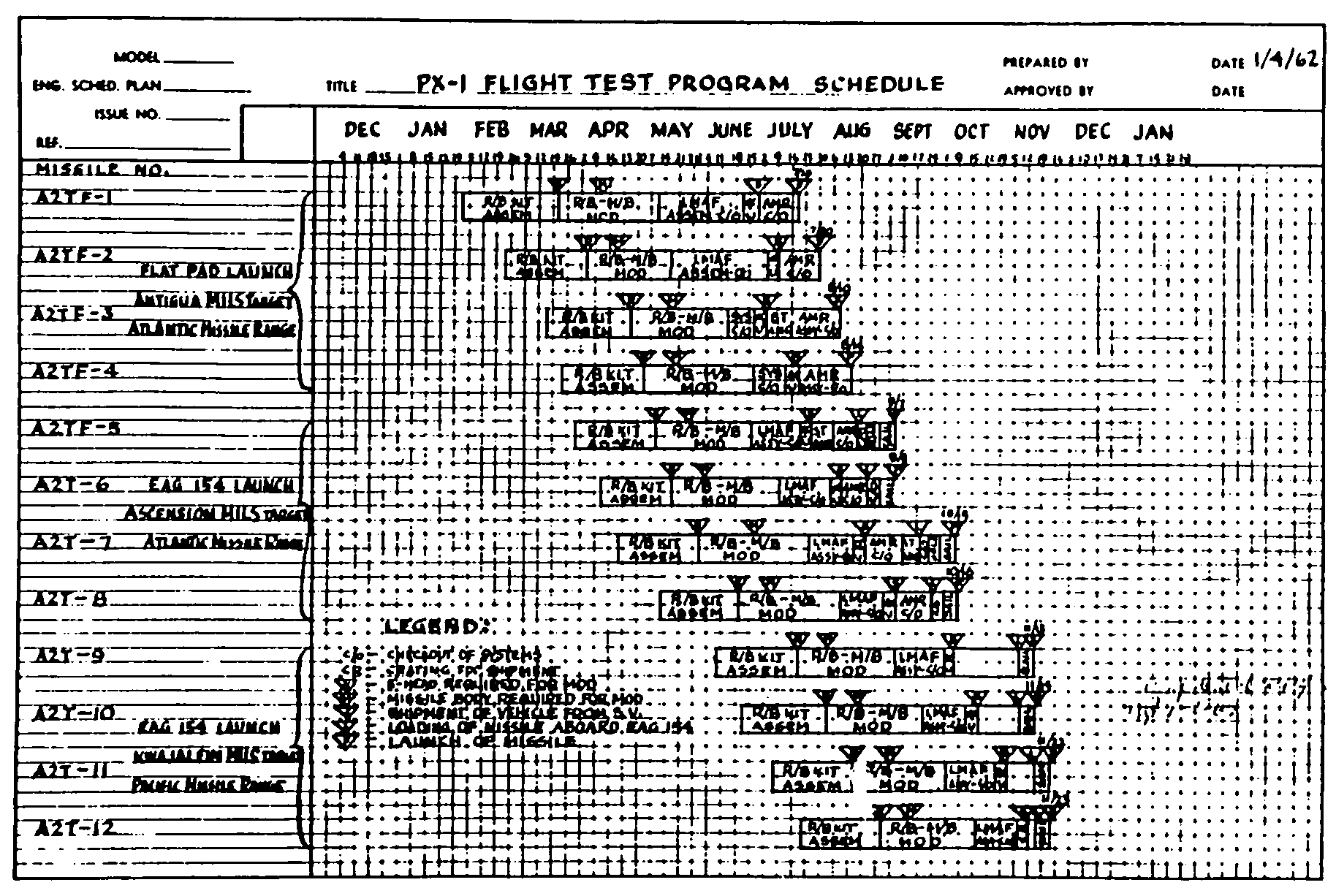
Figure
22
[DELETED PARAGRAPH OR TWO]
"We also have a parallel development towards the possible deletion of the chemo-electric generator for initiating the thermal battery. At NOL, development is proceeding to actuate the battery inertially. We are going to carry this project forward in parallel flight test until we get enough data; we expect to get rid of the CEG from the flare as well as the wires that clutter up this space here, and make it sensitive to countermeasures.
[DELETED PARAGRAPH OR TWO]
"Regarding the deletion of the required ejection of the rocket motor spent case, the original decision to eject this was based on aerodynamic considerations, static margin and CG. Re-evaluation of our static margin and CG situation has shown that we do not need to eject. To save complications, we will retain the spent case without the spring and ring. We do not need the spring compression tool assembly so it will be a faster package and might be slightly cheaper. Another potential advantage, and one not fully explored in the Mark 2 penetration aids system, might be realized by going to a Mylar covering to protect against X-rays instead of ejecting the re-entry body in the trajectory. This job may be easier if we do not have to eject the spent motor case.
[DELETED PARAGRAPH OR TWO]
"You may recall the memoranda and letters dated in October following a study made by Field Command DASA on the subject of permissive links. The permissive link is an electromechanical device or some sort of system put into the arming circuit to deny the custodian of the weapon the ability to arm its warhead.
"The Re-entry Body Coordinating Committee has set up an Ad Hoc Subcommittee to study the incorporation of this permissive link in both the Mark 1 and Mark 2 systems. We expect a report on feasibility, desirability, and the most amenable techniques for incorporation in the Mark 1 by March, and the Mark 2 by June. We propose to submit this as a recommendation to the CNO for his further action.
"I have one item under progress leading to future decisions. As mentioned before, the present Mark 2 re-entry system design is vulnerability-oriented to the point that an interdicting warhead of one-half megaton yield directed to killing one of the elements, will not be able to kill more than one.
"The spacing we have provided the system remains good up to higher yields, and 1.8 megatons shot at one of these would not kill either of the other two. We presume the defense system will have an intercept distance as good as ZEUS, but would not have the sensitivity to let the defense shoot at the middle. If they could shoot at the middle of the pattern, then we are not good to 1.8 megatons, but only to one-half megaton -- the design criteria.
"There have been suggestions that the presumed defense yield is not high enough, and that systems are possible with yields of three, five, or ten megatons. We have a study now that shows what changes are needed to increase the separation of the existing system to counter a five-megaton yield. With these changes five megatons directed at one element will not kill either of the other two. The changes include small increases in the impulses of the respective rockets, and some compound rotations of the tilt mechanism. The compound rotations may create interferences between existing snubbers and the separation rings that may require moving the whole re-entry system forward a minimum of about one and one quarter inches. Proceeding this way, we could do it, provided the decision were given immediately to get this new separation system into flight by January of next year in A3X-14. More specifically, this new separation scheme gives us a minimum of 16.5 nautical miles separation between the re-entry bodies at the altitudes of X-ray interest, contrasted to the 6 to 8 miles we have now. The impact separation is preserved at less than three miles in the 2000 to 2500-mile ranges. Below 2000 miles the impact separation goes up to about four miles in some cases, but we were working with ground rules to stay with the 2000- and 2500-mile range and to keep the impact separation where it is now, and make the separation altitude good enough to counter five megatons against multiple kill.
"We are using three-dimensional separations of the elements generally along the trajectory. The impact pattern is somewhat perturbed. While it no longer is a nice equilateral triangle, particularly at ranges between 2000 and 2500 miles, it is as good as we have in the existing system, and we would be able to preserve the impact pattern and still have a three-mile separation of components, firing the full range. As the range is shortened, the separation distance tends to increase slightly, and the impact pattern goes badly askew from the original equilateral triangle. This becomes reflected in a loss of system effectiveness at the shorter ranges of about five per cent."
Mr. Peterson argued that the enemy, if he took a good look at the threat posed and the nature of its arrival over his cities, might turn to the centroid detonation as the most effective and economical means of defense; the enemy would certainly try to determine the least expensive efficient means of hurting the POLARIS system, and the centroid solution would probably be that means.
Captain Clarke observed that cities would be the prime targets for the re-entry system under discussion and that these defensive techniques would probably not be worth much. Mr. Eyestone agreed, adding that their worth may become lessened if it is remembered that the defender is not going to know necessarily what type of missile Î6-attacking him.
"What is our estimated range penalty right now for the Mark 1 Re-entry Body on the A2 missile?" asked Captain Clarke.
[DELETED PARAGRAPH OR TWO]
Captain Clarke asked about use of this package in the A1 missile, but Admiral Smith doubted the value of putting this package in the A1 missile.
Dr. Hartmann asked for details on the permissive link studies committee.
"The committee included members from SP, NOL, Livermore, NEWF, Op75, and others," replied Commander Julian.
Commander Julian then explained that the PX program has not yet received approval from CNO, and there is a suspicion that Secretary Wakelin wishes further details on it. "I intend, " continued the Commander, "to deliver copies of the PX-1 and PX-2 plans and possibly a copy of the feasibility study to Op37 for additional information."
"I should like to note, " said Admiral Smith, "before we get any further questions, that the purpose of the PX program is to make the A2 missiles that we have, or will have, significantly better. We do not propose to make the A2 as perfect as the next model. We plan, and in principle the plan is approved, to retire and replace these missiles before they wear out. This plan is a result of quite general intelligence that the Russians are jumping to the defense task and putting somewhat more effort in it that we had anticipated.
"There is not, as far as I know, a great deal of specific information about their progress, but we do know that they are doing far more than had been anticpated, and we can expect them to have a working defense system at a somewhat earlier date."
Dr. Barrow asked about the possibility of more exotic counter-measures such as energy saturation, RF power, death rays, optical lasers, and similar techniques.
"The best answer there, " replied Admiral Smith, "is that we are not thinking beyond the A3 timetable and the defensive capabilities of the nuclear warhead on an AICBM. When we start thinking beyond the A3 program, we can concern ourselves with the problems of these future kill mechanisms."
With no further discussion, Admiral Smith then introduced Captain Gooch for presentation of the Launching Committee Report.
SUMMARY DISCUSSION
After discussion of Dr. Craven's report, Admiral Smith returned the subject of discussion to Commander Julian's presentation. "I have some questions in my own mind, " he stated, "mat I feel need further discussion and possibly a decision. One, Commander Julian reported on the increased separation of these three re-entry bodies and spoke of it as something for a future decision. I feel that maybe the decision time should be right now. There is one factor that has not been brought into the discussion - - a DOD memorandum or directive, setting up a review of all the strategic weapon systems from the point of view of predicted penetrability. There is a very flat statement by Mr. McNamara or Mr. Gilpatric that the future procurement of systems and decisions on force level will be based on the expected performance as indicated by this review because they are all interrelated. He is quite serious about it.
"Next, while we do not really know what warheads will be used against what defense model, there are strong indications that it will involve larger than a half-megaton warhead. While I do not know precisely what this intelligence is based on, I am sure there is also a general feeling that the Russians will take this sort of approach; I feel it makes good sense. We would expect them to go about this problem this way rather than try the very elegant minimum miss-distance technique. Thus the figures that Commander Julian gave us about the effect of aiming at the center one of three are pertinent. We can well wonder about what size warhead it would take to kill the other two elements.
"That takes us to yesterday's question about setting the system up so that we could feel reasonably certain of getting two out of the three into the target, and setting the spacing of elements accordingly."
Commander Julian stated that yesterday's spacing figures were on the optimistic side, and that the new spacing would protect generally against 2.5 megatons; the current spacing would protect for half-megaton blasts.
"I do not think we will fare too well in the DOD analysis," replied Admiral Smith, "as I feel that the defenders might find a way to kill two of the three elements with a half-ton warhead. Frankly, I think we should decide right now to go to the wider spacing which will carry us through a 2.5 megaton attack."
"Who are we competing with in this analysis, " asked Dr. Mechlin, "and what are the alternatives?"
Admiral Smith pointed out that the wider separation would, in effect, require the defenders to employ many more AICBM's to reduce the effectiveness to that of the closer-spaced elements.
"If we only get one of the three into target, " said Commander Julian, "we may still be better off than with the single re-entry body system of the Air Force. If the enemy can discriminate, he can kill the single re-entry body but he would not be able to kill all three of ours unless his yields are stupendously large."
Admiral Smith pointed out that the defenders would have to come closer to damage the single element system, for the single element system can be better protected, has more weight for this purpose, by a factor of five over the POLARIS re-entry elements.
"What do we pay for this new separation?" asked Mr. Geckler.
"Very little, and that only at the near-minimum range, " replied Captain Wootton.
Mr. Burriss inquired about why the decision needed to be made at this time and what jeopardy the missile would be in should the decision be made at a later time. Commander Julian explained that the decision could not be avoided and must be made very soon. "The first flight is the A3X-14 and if we wait three or four months, we will not have a chance to get any flight data fed back into the final design release of the system."
Admiral Smith agreed that the decision should be made now. No other member disagreed with this.
Dr. Mechlin asked about the Air Force efforts in redesign, and Admiral Smith explained that the Air Force was moving to a needle-shaped re-entry body which, if pointed right on the radar, would have a very small cross-section. Mr. Peterson added that the plan was sound, could be demonstrated as practicable, and that the AF people had a right to be quite hopeful about it. Dr. Frank pointed out mat the elongate shape would have a greater vulnerability to X-rays, a problem which has not as yet been solved.
"The only argument against wider separation would be the loss of effectiveness at shorter ranges," commented Dr. Frank.
"The existence of the A3 argues well enough against the shorter ranges, " stated Admiral Smith.
"The average net loss in effectiveness will be about five per cent," said Commander Julian, "although this figure assumes a non-rotating Earth. Add the element of rotation, and there will be some increase at particular azimuths and latitudes."
Admiral Smith summarized by noting that the three warhead cluster had an advantage in that discrimination was not possible between the elements; but while this advantage was basic, it was only good up to a certain yield in defensive warheads and once that point is passed it becomes meaningless; the enemy does not have to discriminate when he can blow up the entire works with one warhead.
"An alternative here, " observed Dr. Mechlin, "is to increase the miss-distance or the CEP, as the objects will become more obscure with greater separation. Frankly, what I have heard does not sound like a practical approach for our timescale. It seems to me that if we are going to change, we might wish a bigger change. "
Dr. Frank objected in that weights might be changed by this, but Commander Julian pointed out that weights were bound to change too and cited the recent development of a change in the plutonium allo-trope now being used as the kind of change that would affect weight, ease the vulnerability problem, and solve some production difficulties.
With no further discussion, it was assumed that agreement had been reached that the change should be made, and that it should be made soon so that there would be no loss in test data.
"I think that next we should take up the problem finally of freezing design plans in respect to the experimental weight-saving program that we devised as a help in preserving the 2500-mile range," said Admiral Smith.
"We have already heard, " he continued, "of the problem we have had and the state of progress in getting the A2 into production. If you go back in your memory to when we started with the A2. it was supposed to be an AI plus 30 inches. The original proposal was to add 30 inches for the cylindrical section of che first-stage motor. This was modified, but tu a considerable extent we got the A2 performance in this simple fashion. From this we can assume that there should have been a great deal of carry-over of parts and experience. According to the schedule, we had four or five months to get the first 16 or 19 missiles out. which is quite a long period to build ir
"In the A3 program we are faced with two things: one, the accelerated submarine building program and, two, we are forced into a schedule for delivery almost at the deployment of these submarines. If we do nut follow the rather sharp buildup in production of the A3, then each month that we miss this date, there will be a submarine all set to go and no missiles to go into it.
"Stark reality stares us in the face, and there is little in the way of choice here. We may miss the date a little, but we must come pretty close to the time these submarines are coming out. For one thing, BuShips has another submarine right behind that one it is pushing on, and this submarine production program will keep rolling all the time. For another reason, we are committed to shift over to A3's, and we simply do not have any A2's to go in the submarines. There seems little hope that DOD will put up the money to buy enough A2's to match.
"We have pious hopes and plans to do all the things right in preparing to get ready for this production. I am quite concerned as a result of the Missile Committee presentation about the number of things that we plan to do fairly well downstream in the development and in the test program primarily for the purpose of getting 90 per cent assurance of having no less than 2500 miles. Frankly, gentlemen, the time of our schedule may run out on us before we even arrive at that assurance. "
After Admiral Smith had concluded his statement of the problem, Mr. Burriss gave a short talk in which he defined the following three items as being important enough for group consideration:
1. Special Projects had a very difficult time with the A3 during the DDR&E stages, particularly in trying to demonstrate the need for a 2500-mile missile as opposed to a 2200-, 2300-, or 2400-mile missile.
2. While the 2500-mile range may have political and other significance, it would be a serious mistake for SP to back off from that range merely from the psychological value that achieving this range would have in the program.
3. The thing that most hurts our schedule at present is the dedication, and often over-dedication, to product improvement through all manner of increasingly stringent requirements that both SP and the customer have been imposing. By way of example, the flight control package on the A1 had a six-hour test and checkout, but the flight control package in the early A2 work required a 28-hour checkout run. Things like this really complicate schedules.
"I would like to suggest," continued Mr. Burriss, "a more rational approach. At this time, I do not think the range determines the schedule and I think we should conduct ourselves accordingly. Backing off from the 2500-mile range would be, I think, a little bit dangerous."
Admiral Smith cited the example of the redesign of the second-stage fluid injection system as a fairly major change required mainly because of the need to hold the 2500-mile range, and expressed a wish for further details on the 'psychological values.'
"My own troops would cut my throat if we should cut the range figure back at this time. " replied Mr. Burriss, "although I must grant that a range cutback might be needed further downstream and we might then have to accept it. Right now, I think we should keep it."
"I do not, for my part. " said Mr. Geckler, "feel there is any magic in the 2500-mile figure. My concern is with all the misinterpretations that will occur if we try to hold down changes to keep this schedule. I would not like to see a change that would help keep the schedule turned down merely because it might have an effect on range. This has already happened too many times."
"There are many ways of carrying out rules, " said Admiral Smith, "but I think the important thing here is to balance the importance of range versus scheduling. Frankly, I feel that we are going to seriously injure the program if we do not meet the schedule."
Mr. Geckler agreed, pointing out that the greatest present schedule problem is with the first stage A3 nozzles, and that changes made in the nozzles to aid the scheduling problem may also seriously affect the weight.
"The pressure on our program, " continued Admiral Smith, "is now towards judging every proposed change on the basis of its help or hindrance in meeting the schedules, so that we will be ready to produce this missile at the time we are scheduled to produce it."
"The nozzles are a good example," replied Mr. Burriss "for it is highly possible that the proof testing of these nozzles will show us that we have problems we cannot correct within our present weight allowance. If that should come about, then we should at that time make the decision about the effect on range. We have already faced this problem in one area where the range has fallen below 2500 miles because of the weight allowance for the penetration aid package."
"I do not think we should make a blanket statement about this problem, " said Mr. Geckler, "but rather should visualize and evaluate the individual problem as it comes into being."
Dr. Mechlin agreed in principle here, mentioning that he had already started to feel the effects of having designed the launch system in optimum terms for meeting the schedule, in spite of the weight penalty. Mr. Burriss also agreed that the program should optimize on meeting the schedule, but should not at this time accept range degradations. Mr. Peterson, however, suggested that the present efforts should be directed towards keeping the weight down, as this seemed to be a policy that would not limit anything for at least the next six months.
Mr. Burriss concluded that the matter should be kept as a gentlemen's agreement at the present, if only to avoid the psychological problems. After a short discussion of dates for the next meeting, Admiral Smith assigned the 22nd and 23rd of March as meeting dates and adjourned this assembly of the Steering Task Group.